The ripple effects of COVID-19, new tech developments, and evolving workplace dynamics have spurred global sectors to recalibrate business models and redefine how we work.
Strategic acumen across people, processes, and technologies at every level is crucial to effectively maintain the pace of transformations designed to address these challenges. These plans should focus on investments in digital technologies that deliver new value and contribute towards an agile ecosystem primed for innovation.
Smart office technology emerges as an essential enabler for business leaders looking to future-proof their organizations. This paradigm shift is not just about physical location; it embodies a fundamental digital transformation, redefining the core aspects of work and organizational structures.
Statista reveals the global smart office market is projected to skyrocket to over $66 billion by 2027, showcasing a remarkable surge in adoption and economic impact. This surge highlights the increasing integration of smart technologies in workplaces, transforming business operations and employee workflows.
This guide explores smart office technology, shedding light on its definition, main components, systems, and available tools. Tailored specifically for Chief Information Officers (CIOs), it provides an in-depth examination of smart office technology’s pivotal role in reshaping modern workplaces.
- What is smart office technology?
- What are the main components of a smart office?
- What are the different types of smart office systems?
- What are the different types of smart office tools?
- Choosing the perfect smart office technology system
- What are the benefits of smart office technology?
- What are the challenges of smart office technology?
- Is your workplace suited for smart office technology solutions?
What is smart office technology?
Smart office technology describes integrating advanced digital tools that enhance workplace efficiency and collaboration. This encompasses IoT devices, AI-driven systems, and automation solutions that streamline operations, optimize resource utilization, and improve productivity.
In the context of Industry 4.0, smart offices align with the broader digital transformation trend, leveraging data analytics and connectivity to create intelligent, responsive work environments. Businesses investing in smart office technology gain a competitive edge and are likelier to excel in innovation and adaptability.
As we race towards the future, this technology becomes more than an investment; it evolves into a strategic imperative, enhancing employee experience, attracting top talent, and ensuring long-term sustainability.
In a nutshell, smart offices enable the following:
- Elevating meeting productivity: Smart offices provide a more efficient and streamlined collaborative environment.
- Empowering seamless workspace discovery: Smart offices enable employees to swiftly and effortlessly locate environments that perfectly cater to their needs.
- Fostering heightened efficiency: Smart offices empower organizational leaders by providing support in optimizing the utilization of tools and spaces for enhanced productivity.
What are the main components of a smart office?
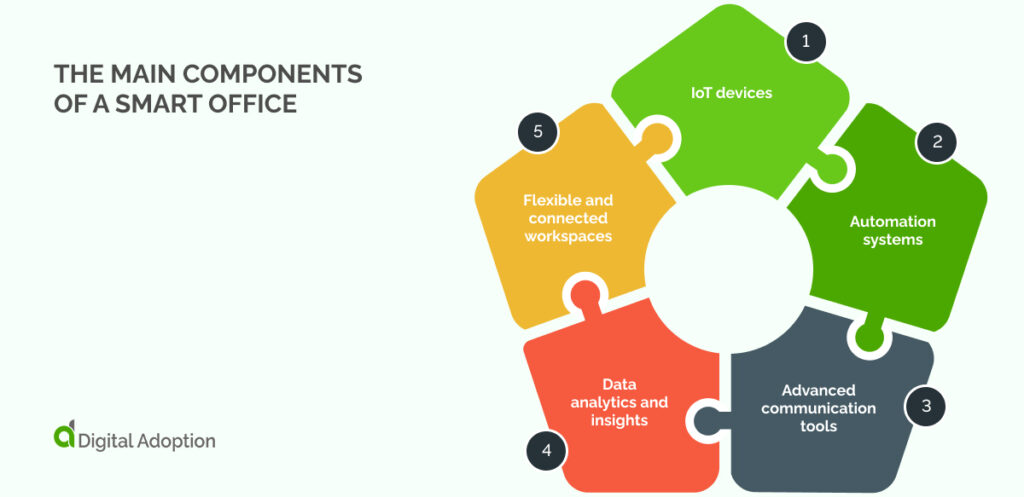
Understanding the diverse components that constitute a smart office gives us a glimpse into the intricacies of modern workplace technology and serves as a key compass for businesses navigating the path to enhanced efficiency, seamless collaboration, and innovative workspaces.
Let’s take a closer look:
IoT devices
Smart offices incorporate a sophisticated ecosystem woven with interconnected Internet of Things (IoT) devices. These encompass a myriad of sensors and intelligent appliances strategically deployed throughout the workspace.
IoT devices work synergistically to continuously collect and share real-time data, forming the backbone of automation and process optimization. From tracking workspace utilization and employee movement patterns to monitoring equipment usage, the extensive data gathered by IoT devices provides valuable insights for businesses.
This information lets companies make informed decisions in real-time, enabling dynamic adjustments to optimize operations.
Automation systems
Leveraging automation technologies, smart offices offer significant benefits to businesses, particularly for CIOs and executives.
These intelligent systems streamline mundane tasks, allowing leadership to focus on strategic decision-making. Automation extends beyond routine activities to control critical environmental factors, such as lighting and climate, creating comfortable and productive workspaces.
This contributes to employee well-being and aids executives in promoting a conducive work environment that supports innovation and collaboration. The overall result is a boost in operational efficiency, enabling CIOs to lead with greater agility, make data-driven decisions, and ultimately drive the company toward sustained growth and success.
Advanced communication tools
Smart offices have cutting-edge tools and offer distinct communication advantages for CIOs and business leaders.
Integrating video conferencing systems, collaboration platforms, and unified communication solutions facilitates seamless and efficient employee interactions. For CIOs, this means enhanced connectivity and real-time collaboration, irrespective of geographical distances.
These advanced communication technologies improve internal teamwork and strengthen external partnerships. Executives can leverage these tools to conduct virtual meetings, share critical information, and make swift decisions, optimizing operational processes.
Data analytics and insights
Smart offices integrate advanced data analytics, unlocking invaluable benefits for CIOs and business leaders. This integration harnesses data from diverse sources, providing actionable insights that empower informed decision-making.
Executives can gain a complete understanding of operational trends, employee productivity, and resource allocation, fostering strategic planning and optimization. This data-driven approach enhances the efficiency of business processes and positions CIOs to navigate challenges with foresight.
The result is a dynamic and adaptive workplace that aligns with the organization’s goals, ensuring CIOs can steer the company toward sustained growth and competitive advantage in an ever-evolving business landscape.
Flexible and connected workspaces
Smart workspaces and meeting rooms revolutionize the contemporary office landscape.
These environments integrate smart furniture, flexible layouts, and advanced connectivity solutions tailored for adaptability, ensuring employees’ seamless collaboration experience regardless of location.
In these innovative spaces, groups can meet and collaborate synchronously, transcending geographical barriers. CIOs and business leaders leverage these intelligent features to enhance agility, efficiency, and strategic decision-making.
What are the different types of smart office systems?
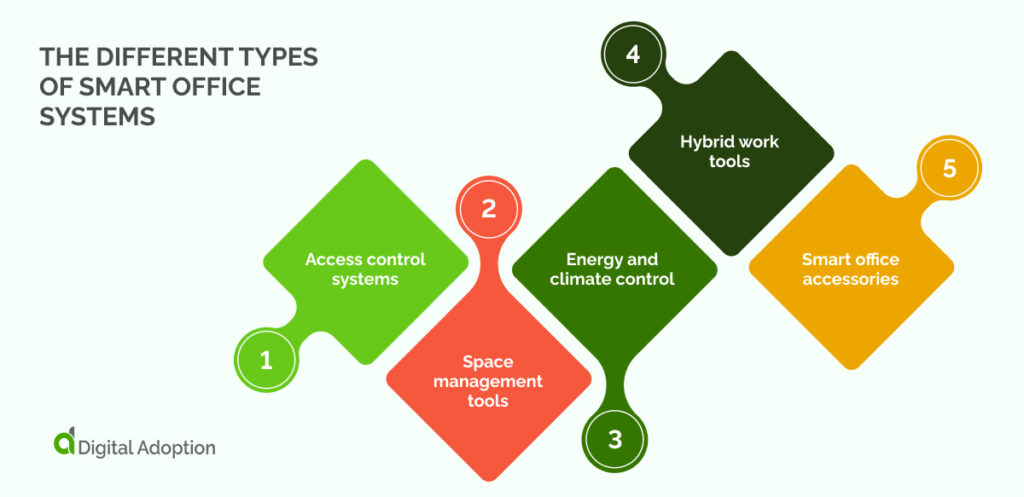
Knowing different smart office systems is crucial for businesses, helping them integrate tailored technologies to boost efficiency and create a more productive workplace aligned with their needs.
Let’s take a closer look:
Access control systems
Strengthen office security by implementing advanced access control systems that provide effortless and efficient access management.
Enable the approval or denial of access requests through mobile devices, ensuring real-time control and heightened security. The cloud-based security system provides instant video camera views, allowing you to monitor your premises remotely. In emergencies, activate the lockdown system remotely for immediate response.
Two-factor authentication adds an extra layer of security, while simplified visitor management streamlines the entry process. Achieve a fully connected office by seamlessly integrating with other smart systems, providing access to real-time data and reports for effective emergency responses and future planning.
Space management tools
Revitalize office layouts with state-of-the-art space management tools, delivering instant visibility into meeting room and desk availability for a seamlessly optimized office experience.
Gain valuable equipment usage insights to inform strategic investments and analyze frequently used office spaces for effective optimization. Streamline booking management for employees, ensuring easy access to available spaces and facilitating efficient use.
In emergencies, track employee locations for enhanced safety and response coordination.
Energy and climate control
Ensure a comfortable and sustainable office environment with smart energy and climate control.
Achieve optimal office temperatures through automated adjustments based on user preferences, usage patterns, and external weather conditions. With intelligent climate control solutions, you can even improve energy efficiency, reduce environmental impact, and enhance overall workplace well-being.
Hybrid work tools
Facilitate the transition to hybrid office models with cutting-edge tools.
Utilize video conferencing software for global connectivity, ensuring seamless communication across distributed teams. Foster inclusive remote collaboration with virtual whiteboard software, enhance video call quality with top-notch webcams and enable universal data and file access through cloud servers.
Embrace a human-centric office space with tools that support effective communication and collaboration, promoting productivity regardless of physical location.
Smart office accessories
Transform your workplace with smart office accessories to elevate efficiency and user experience.
Seamlessly integrating into workspaces, these cutting-edge accessories enhance functionality. Experience ergonomic desk setups prioritizing comfort and productivity alongside intelligent task lighting solutions adapting to preferences.
The commitment to delivering a technologically advanced and user-friendly office environment is reflected in each accessory, promising a harmonious blend of innovation and convenience for a more dynamic workplace.
What are the different types of smart office tools?
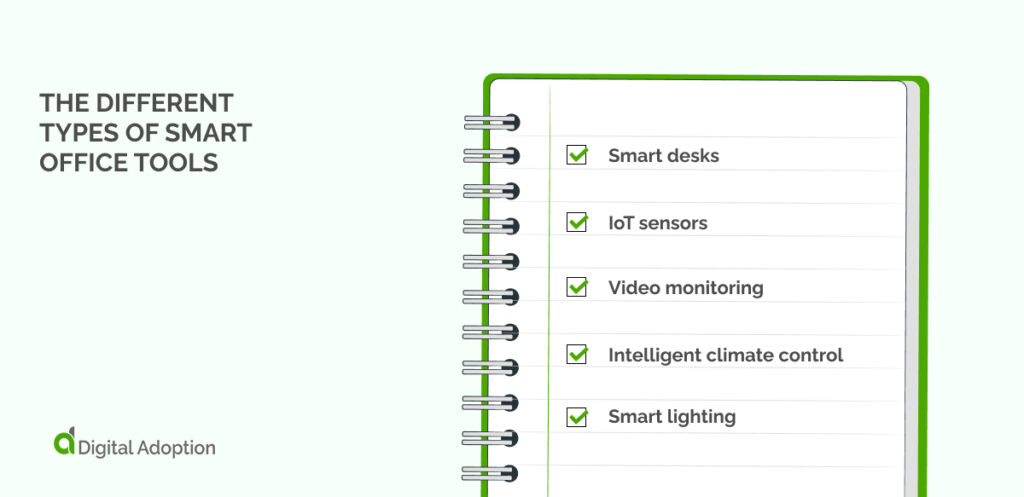
Now that you have an overview of the different types of smart office systems, gaining insights into a range of smart office tools is crucial for C-level executives. This knowledge empowers them to adopt customized technologies strategically, elevating operational efficiency and productivity within the organization.
Let’s take a closer look:
Smart desks
Smart desks offer a new way to work, simplifying workspace allocation with features like searchable and reservable options. They provide insights into usage patterns, which aids in efficient resource management. Employees benefit from personalized settings that enhance comfort and productivity.
Moreover, usage tracking data enables ongoing refinement of workspace dynamics, ensuring adaptability to changing needs. This practical technology integration promises efficiency and boosts employee satisfaction, making smart desks invaluable assets for future-ready businesses.
IoT sensors
In the modern office, strategically placed IoT sensors work behind the scenes to improve efficiency. By detecting occupancy, they provide real-time data that helps optimize space usage and improve workplace operations.
This data isn’t just for show—it’s integrated into systems like lighting and climate control to save energy and create a more comfortable environment for employees based on actual usage patterns. These sensors give businesses a clearer picture of how their office functions and help make smarter decisions for a better workplace experience.
Video monitoring
Boost office security with advanced video monitoring systems with wide-angle views and cloud storage capabilities. These systems provide comprehensive coverage, minimizing blind spots and ensuring a secure workspace. Additionally, low-light capabilities enhance safety during nighttime monitoring, maintaining vigilance around the clock.
Organizations can proactively identify and address security threats by leveraging video analytics and enhancing office security. These systems utilize advanced features to create a safer work environment for employees and visitors by adopting a proactive approach to security.
Intelligent climate control
Intelligent climate control systems are at the forefront of smart office tools, revolutionizing how workplaces manage comfort and energy efficiency. By seamlessly adjusting temperatures based on occupancy patterns, these systems create a comfortable environment without manual intervention.
One of the key advantages is their ability to integrate with other smart technologies, such as occupancy sensors and weather forecasts, to optimize energy usage and enhance employee comfort. Additionally, some systems offer individualized temperature control, allowing employees to personalize their workspace according to their preferences.
Smart lighting
Smart lighting solutions, powered by LED technology and IoT sensors, offer up to 90% energy cost reductions. Users personalize lighting via smartphone controls for tailored brightness levels.
Incorporating luminance controls optimizes brightness to natural daylight, fostering an energy-efficient workspace. Moreover, smart lighting enhances user experience in a connected and responsive environment, making it a valuable investment for businesses prioritizing efficiency and comfort.
Choosing the perfect smart office technology system
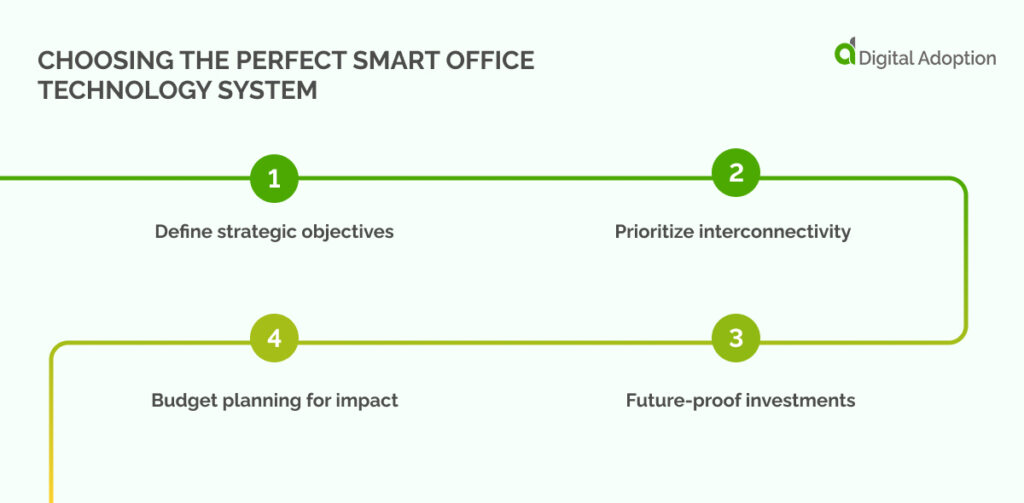
Now that you better understand smart office technology tools, executives choose the most appropriate system to align with their organizational objectives.
This involves careful consideration of specific company needs, evaluation of available technologies, assessment of scalability and integration capabilities, and thorough cost-benefit analyses before making an informed decision.
Here’s a step-by-step guide to navigating this decision-making process:
1. Define strategic objectives
Identify the primary smart office technology that aligns with your organizational goals.
Whether optimizing a hybrid work model or enhancing workplace safety, pinpoint the technology that directly supports your key objectives.
2. Prioritize interconnectivity
Emphasize the importance of interconnectivity, a cornerstone of effective smart offices.
Evaluate the compatibility of potential smart office solutions with existing systems.
Explore integration possibilities, such as combining smart sensors with camera systems for enhanced real-time insights into office access.
3. Future-proof investments
Assess the scalability of the chosen smart office solution to accommodate future growth.
Ensure the system can adapt as your organization expands, saving time and costs associated with adopting a new system.
4. Budget planning for impact
Set a budget after identifying priority smart office technologies and prioritize systems based on immediate business needs, considering factors like productivity, security, or collaboration. If budget constraints dictate a phased approach, focus on the system that delivers the most significant impact for optimal resource utilization.
What are the benefits of smart office technology?
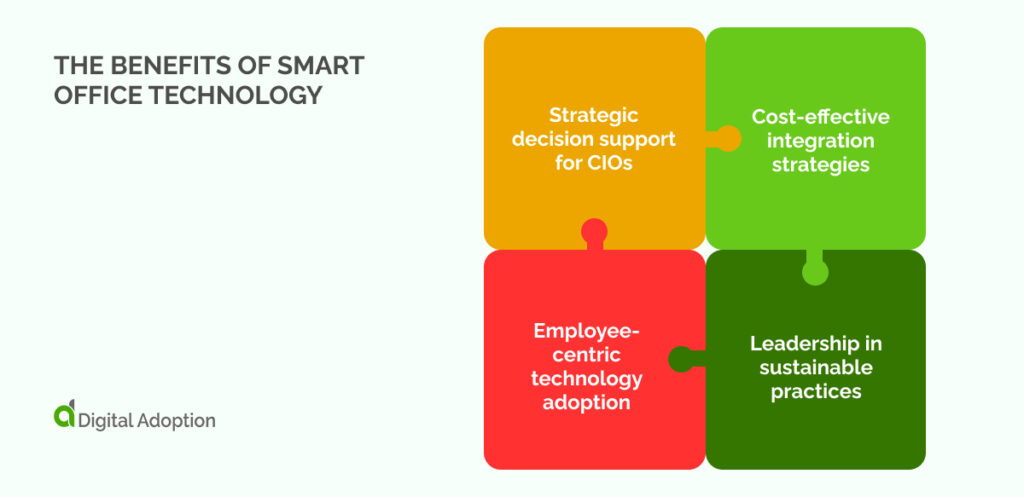
Smart technology has many benefits, but the key lies in effectively understanding and implementing these advancements.
Organizations that grasp the potential advantages and adopt best practices for implementation stand poised to elevate operational efficiency, enhance employee satisfaction, and gain a significant edge in the competitive business landscape.
Let’s take a closer look:
Strategic decision support for CIOs
Smart office technology offers CIOs real-time insights into key metrics. To leverage this, CIOs should invest in systems that align with their strategic goals. Implement analytics tools that provide actionable data for informed decision-making, enhancing the CIO’s ability to steer the company effectively.
Cost-effective integration strategies
CIOs should prioritize smart office solutions that offer seamless integration with existing systems. This prevents costly disruptions and ensures a smooth transition. Careful planning and phased implementation can help CIOs avoid unnecessary expenses and maximize the return on investment.
Leadership in sustainable practices
CIOs can champion sustainability by selecting smart technologies with energy-efficient features. This aligns with environmental goals and contributes to long-term cost savings. Implementing eco-friendly practices positions the company as a responsible corporate citizen, enhancing its reputation and appeal.
Employee-centric technology adoption
Choosing technologies prioritizing user experience is crucial for CIOs aiming to enhance digital engagement. Implement solutions that facilitate collaboration, support remote work, and offer personalized features. This approach boosts productivity and fosters a positive work environment, contributing to talent retention and attraction.
What are the challenges of smart office technology?
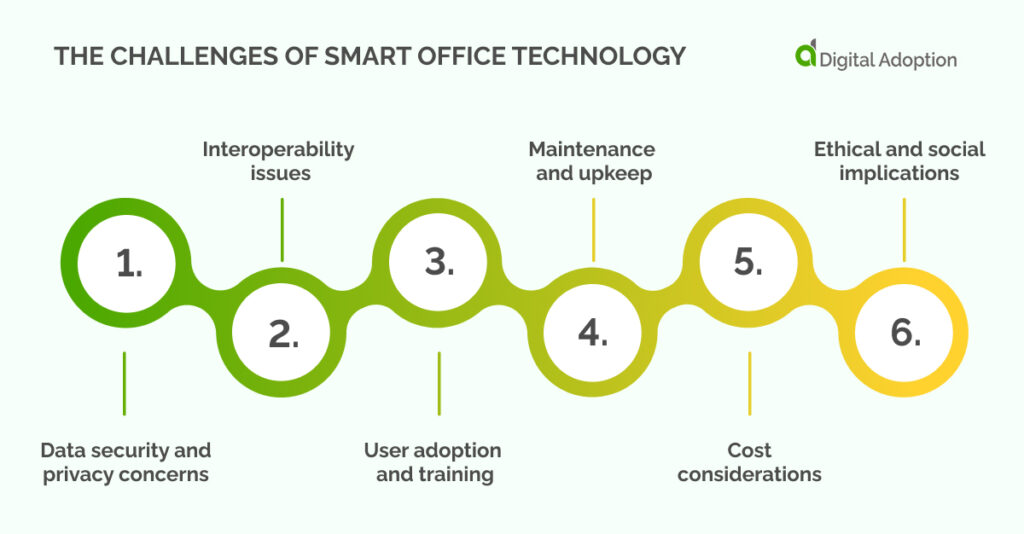
Smart technology has various challenges, from data security concerns to interoperability issues. Failure to address these challenges properly can result in compromised data security, inefficient workflows, and missed opportunities for innovation and growth in working environments.
Below, we explore organizations’ top challenges when implementing smart office technology.
Data security and privacy concerns
As smart office technology collects and processes vast amounts of data, organizations must prioritize data security and privacy. Critical considerations include safeguarding sensitive information from cyber threats and ensuring compliance with data protection regulations.
Interoperability issues
Integrating various smart office devices and systems from different vendors can be challenging. Ensuring seamless communication and compatibility between other technologies requires careful planning and coordination to avoid interoperability issues.
User adoption and training
Introducing new technology into the workplace can be met with resistance from employees who may be unfamiliar with or skeptical about the changes. Providing comprehensive training and support to employees is essential to encourage adoption and maximize the benefits of smart office technology.
Maintenance and upkeep
Smart office technology requires regular maintenance, updates, and troubleshooting to ensure optimal performance. Managing these tasks efficiently and minimizing downtime is crucial to prevent disruptions to workflow and productivity.
Cost considerations
Implementing smart office technology can be costly, requiring equipment, infrastructure, and ongoing maintenance investment. Organizations must carefully weigh the costs against the potential benefits and consider factors such as scalability and long-term return on investment.
Ethical and social implications
The widespread adoption of smart office technology raises ethical and social concerns, such as the potential for increased surveillance and loss of privacy in the workplace. Organizations must consider the ethical implications of deploying these technologies and establish clear policies to protect employee rights and well-being.
Addressing these challenges requires a strategic approach and collaboration across different departments within the organization. By proactively addressing these challenges, organizations can unlock the full potential of smart office technology and drive sustainable growth and innovation.
Is your workplace suited for smart office technology solutions?
Determining the compatibility of your workplace with smart office technology solutions is pivotal for transformative advancements. As a CIO, asking the right questions can guide your decision-making toward a tech-infused future that aligns seamlessly with your organizational goals.
- Assess your current workflows and identify pain points that could benefit from automation or optimization. Are there communication bottlenecks? Is data accessibility hindering decision-making? These insights will direct your focus toward tailored solutions.
- Consider the scalability of prospective technologies. Will the chosen smart office solutions accommodate your company’s growth? Ensure that the selected systems align with your long-term vision and can adapt to evolving business needs.
- Evaluate the integration capabilities of smart technologies with your existing infrastructure. Seamless incorporation prevents disruptions and ensures a harmonious transition. Prioritize solutions that offer compatibility with your current systems to maximize efficiency.
- Explore the potential for cost savings through energy-efficient features. Smart technologies can contribute significantly to sustainability efforts while positively impacting your bottom line.
Armed with these insights, you can confidently select smart office technology solutions that align with your current needs, positioning your business on a forward trajectory for long-term success and adaptability.

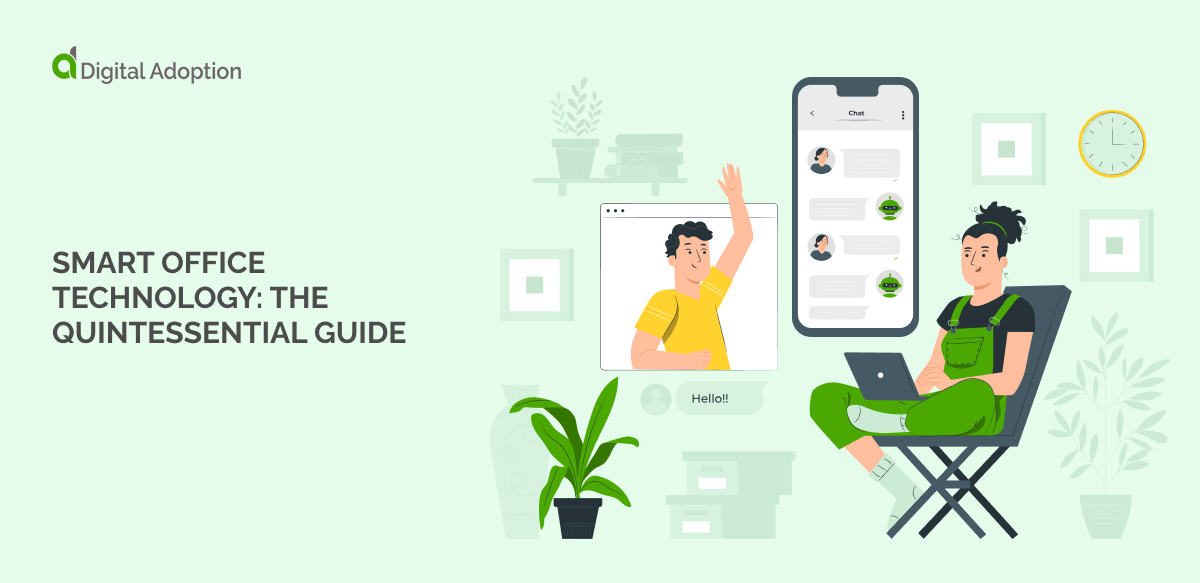


![18 Examples of AI in Finance [2025]](https://www.digital-adoption.com/wp-content/uploads/2025/06/18-Examples-of-AI-in-Finance-2025-300x146.jpg)
![14 Examples of AI in Manufacturing [2025]](https://www.digital-adoption.com/wp-content/uploads/2025/06/14-Examples-of-AI-in-Manufacturing-2025-300x146.jpg)
![29 Examples of AI in Education [2025]](https://www.digital-adoption.com/wp-content/uploads/2025/06/29-Examples-of-AI-in-Education-2025-300x146.jpg)
![15 Examples of AI in Retail [2025]](https://www.digital-adoption.com/wp-content/uploads/2025/06/15-Examples-of-AI-in-Retail-2025-300x146.jpg)
![13 Examples of AI in Healthcare [2025]](https://www.digital-adoption.com/wp-content/uploads/2025/06/AI-in-healthcare-examples-300x146.jpg)


![18 Examples of AI in Finance [2025]](https://www.digital-adoption.com/wp-content/uploads/2025/06/18-Examples-of-AI-in-Finance-2025.jpg)
![14 Examples of AI in Manufacturing [2025]](https://www.digital-adoption.com/wp-content/uploads/2025/06/14-Examples-of-AI-in-Manufacturing-2025.jpg)
![29 Examples of AI in Education [2025]](https://www.digital-adoption.com/wp-content/uploads/2025/06/29-Examples-of-AI-in-Education-2025.jpg)